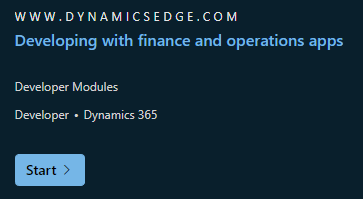Dynamics 365 Finance and Operations Developer Training Apps Developer MB-500

You Can Learn:
- Dynamics 365 Finance and Operations X++ Developer training with Life Cycle Services (LCS)
- Design and develop your AOT elements
- Develop and test your code
- Implement reporting
- Integrate and manage data solutions
- Implement security and optimize
- Plan the right architecture and your solution design
- Apply your developer tools
- Create Workspace for users roles
- Create your entities and fields
- Automate your business processes
- performance
Microsoft Dynamics 365 for Finance and Operations Apps Developer MB-500 with X++ Power Apps
Learn how to Manage your Life Cycle Services (LCS) Projects, write X++ Code, extend database tables. Create, reports and workspace, create and edit forms, work with Models, Data Migration and Extend the Microsoft Dynamics 365 Finance with Solutions from AppSource.
Is this the Right Microsoft Dynamics 365 for Finance and Operations Apps Developer and Core MB-500 D365 X++ training Course for you?
Professionals like you can work with application enhancements, customizing user experience, with system integrations, data conversions, custom process automation, and Power BI Visualization. Power Users, Data Analyst, Developer, Business Analyst can really benefit from the Business Process Modeler
Things Good To Know Before you attend the class:
General knowledge of your Microsoft Dynamics 365 Finance and Operation or another ERP system (examples SAP, Oracle Financials, Lawson, EPICOR)
Some experience can help being a functional or technical consultant analyze business requirements
General knowledge of basic mobile device features and navigation
Course Outline
Module 1: Overview & Architecture
Learn to describe the architecture of D365FO, describe relevant D365FO deployment as well as design factors. Learn how to describe the Dynamics 365 ecosystem and also the major components of the Dynamics 365 Finance and Operations (FO) software,
Lessons
- Explore the technical architecture
- Explore the ecosystem and main components
- Explore design and deployment considerations
- Manage your implementations by using Lifecycle Services
- Work with performance and monitoring tools
- Manage source code by using version control
- Explore the test framework and tools
- Explore reporting tools
Lab : Development Environment configuration and Project/Model Creation
Module 2: Solution Design
Determine the required application stack components and server architecture, Implement Application Lifecycle Management (ALM), Design a solution for D365FO
Get Started with Lifecycle Services
- Understand the functionality and tools of Lifecycle Services
- Reuse existing assets, copy and share data
- Understand Task recorder functionality
- Create a business process model
- Run the LCS Issue Search tool and analyze results
- Learn how to use Regression Suite Automation Tool
- Module Summary
Using Lifecycle Services (LCS) to design and plan your Deployment
- Introduction
- Phases of a cloud implementation
- Phases of an on-premises implementation
- Create Functional Design Documents (FDD)
- Module summary
Lessons
- Implement application lifecycle management
Lab : Data Structure Development
Module 3: Developer Tools
Manage system implementations by using Lifecycle Services, Customize D365FO by using Visual Studio, Manage source code and artifacts by using version control, Work with other development tools to complete tasks
Lessons
- Manage implementations by using Lifecycle Services
- Manage source code by using version control
- Customize by using Visual Studio
Lab : Source Control using DevOps
Module 4: AOT Elements
Create forms, Create and extend tables, Create Extended data Types (EDT) and enumerations, Create classes and extend AOT elements
Lessons
- Build extended data types and enumerations
- Build tables
- Build forms and optimize form performance
- Create classes
- Create other user interface elements
Lab : Metadata Extension & Development
Module 5: Code Development & Testing
Develop X++ code, Develop object-oriented code, Extend D365 FO functionality, Describe test framework and tools, Perform Unit Testing
Lessons
- Explore the test framework and use tools
- Get started with development using X++
- Develop object-oriented code
- Use RSAT tool
Lab : Code Extension & Development
Module 6: Frameworks
Implement D365 FO functionality
Lessons
- Introduction
- Explore extensions and the extension framework
- Extend elements
- SysOperationSandbox framework
- Summary
Lab : SysExtension Framework
Module 7: Reporting
Describe the capabilities and limitations of reporting tools in D365FO, Design, create, and revise Dynamics Reports, Design, create, and revise Dynamics workspaces, Design, create, and revise data sources that connect to data stores external to D365FO
Lessons
- Explore the reporting tools
- Build reports
- Build workspaces
- Manage data sources with external data stores
Lab : Power BI reporting from F&O
Module 8: Integration
Identify Data integration patterns and scenarios, Implement Data integration concepts and solutions, Implement Recurring integrations, Integrate D365FO with Microsoft Azure, Troubleshoot integration errors, Implement the Data Management Package API
Lessons
- Identify data integration patterns and scenarios
- Implement data integration concepts and solutions
- Implement the data management package API
- Data integrations
- Integrate with Microsoft Azure
- Connecting to Power Platform services
- Consume business events
- Integrate Finance and Operations apps with Microsoft Dataverse
Lab : OData Integration
Lab : Logic App Integration
Lab : Calling an External Web Service
Module 9: Data Migration
Describe migration tools and methodologies, Plan Migration strategy, Prepare data for migration and migrate data
Lessons
- Prepare data for migration
Lab : Data Export/Import using Data Entity
Lab : Recurring Data Transfer
Module 10: Security & Performance
Describe and implement performance tools and LCS Environment Monitoring tools, Implement role-based security policies and requirements, Apply fundamental performance optimization techniques, Optimize performance for batch processes, Optimize user interface performance, Enhance Integration performance, Optimize Report Performance
Lessons
- Work with performance and monitoring tools
- Implement role-based security
- Apply basic performance optimization techniques
Lab : Async & Sandbox Functionality
Have a Question ?
Fill out this short form, one of our Experts will contact you soon.
Call Us Today For Your Free Consultation
Call Now